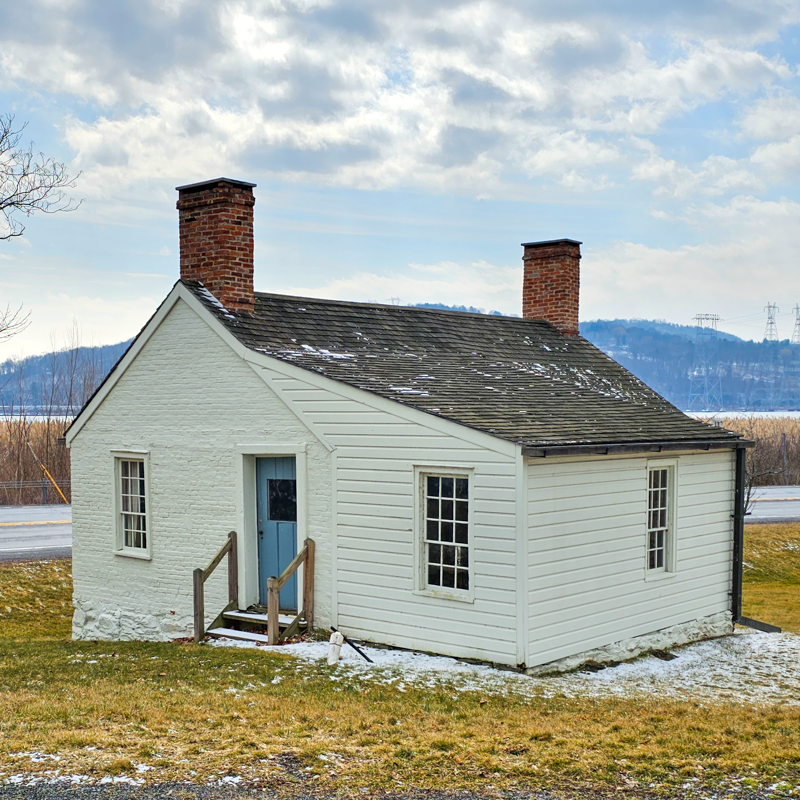JAN VAN LOON HOUSE (1706)
Jan Van Loon’s modest two-room stone house is one of the oldest residences in New York State. The house, with a cellar kitchen, was built near the Indian site Black Rock, where Indians of the Algonquin nation, mostly Mohicans and Delaware, congregated. The present house likely dates from the late 18th or early 19th century with one wall remaining from the original structure. One of two stones salvaged from the original structure bears the inscription “1706, JVL”.
Jan Van Loon was the earliest European settler in Loonenburgh (now Athens) and was the chief holder of the Loonenburgh Patent, securing title to the land in 1685. Jan’s land holdings included a large bowery, part of which in 1800 was sold by his descendants to Isaac Northrup, who was the founder of the Village of Athens.
Born about 1650 in Liege, the capital of an independent bishopric, Jan Van Loon was formerly a Netherlander, although no citizen of the Dutch Republic: he was one of the few Netherlanders who, immediately after the final surrender of New Netherlands by the Dutch to the English in 1674, settled in this country. He arrived in New York in 1675. The minutes of the Common Council of the City of New York, dated November 24, 1675, stated that on that day he took an oath of allegiance to the king of Great Britain. In 1676, two months after his naturalization, he married Maria Jansen Van Ilpendam in New York, in the Dutch Reformed Church; the couple moved to Loonenburgh that same year. Maria had been born in New Amsterdam in 1656. Jan was well educated and spoke French as well as Dutch.
Jan and Maria had four sons, Jan, Albert, Nicholas, and Matthias. Their two daughters, Elsje and Maria, added the names of La Grange and Van Schaack to the family tree. The sons married into the Hallenbeck, Clouw, and La Grange families.
During 1937, this cherished landmark came close to demolition when the highway passing the stone house was realigned. Albert Van Loan (no longer spelled Van Loon) started a petition to save this historic structure, and thanks to Colonel Frederick Stuart Greene, the head of the Department of Public Works, a revised map with an alternate highway route was drawn to save the site.
The descendants of Jan Van Loon held title to his residence into the 21st century. In 2001, Eugene Van Loan, Jr., of Bedford, New York, transferred the house, which now stands on a small triangular-shaped parcel of land, to the Greene County Historical Society. The Society signed a long-term lease with the Village of Athens for its use as a visitor center.
A grant from Athens Generating Corporation, funds from members of the Van Loon family, as well as monies from other contributors allowed the Village to obtain the necessary professional services for the project. The work was administered by the New York State Office of Parks and Recreation.
Archaeological requirements were completed in 2005, and the structural repairs began in the fall of 2006. Randy Evans and his crew rebuilt or restored the east, west, and south walls, south chimney, fireplace, and long-disappeared bake oven. Due to deterioration, similar stone was required to complete the restoration and was obtained from a building foundation on Howard Hall Road.
Since the archaeological study turned up items such as clay smoking pipes and Indian flint tools, and as the building was so near Black Rock, one would wonder if the original structure may have been used as a trading post.
If you are walking through Athens today, the Haight-Gantley House is just west at 38 South Franklin St.

Leave a Reply